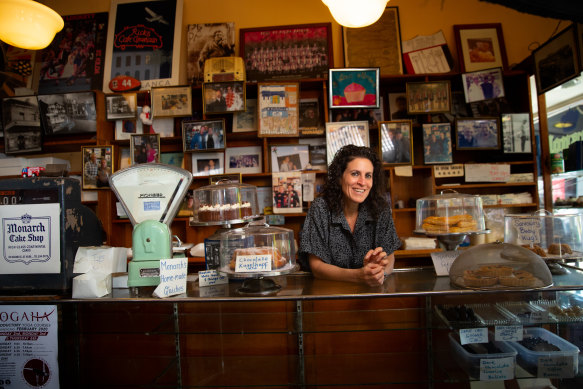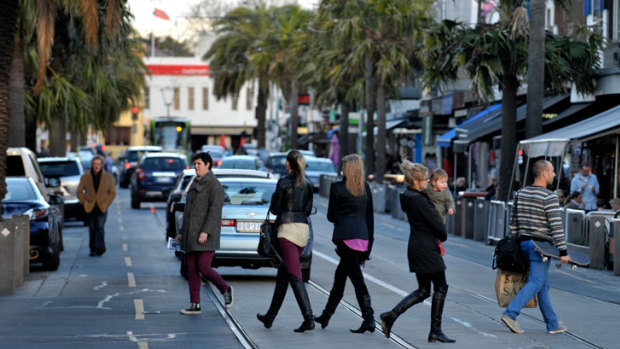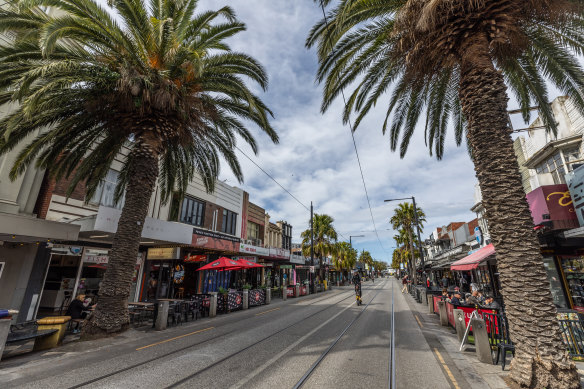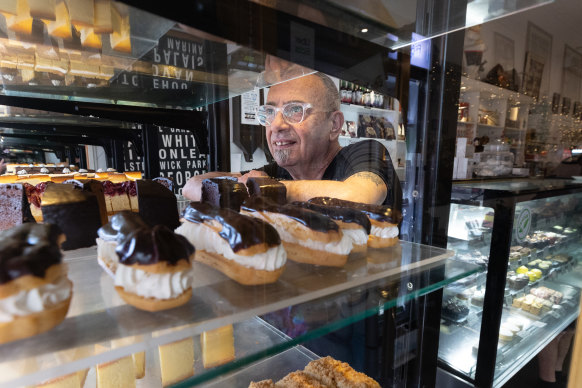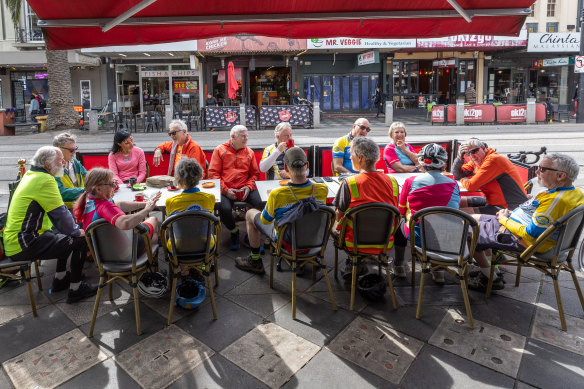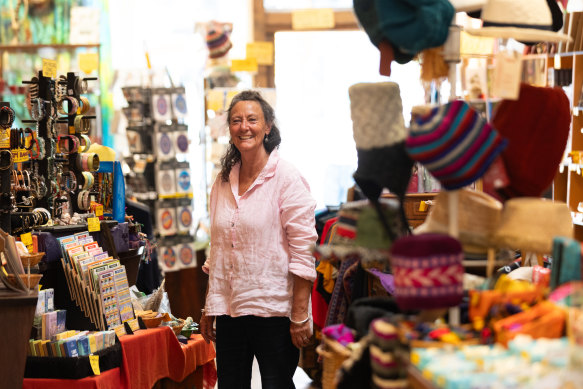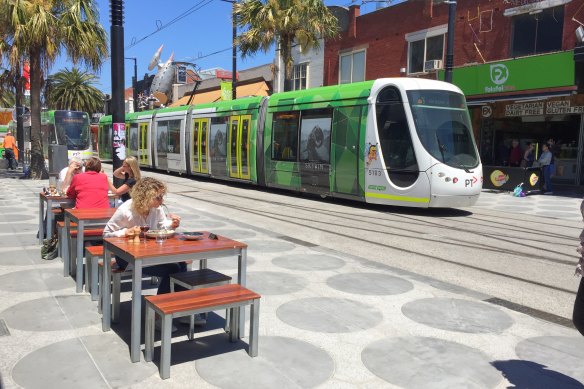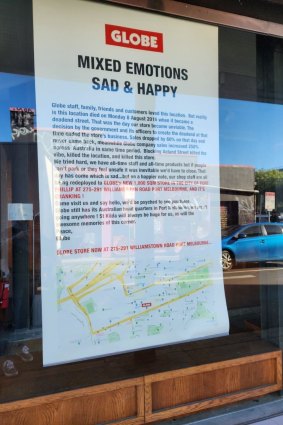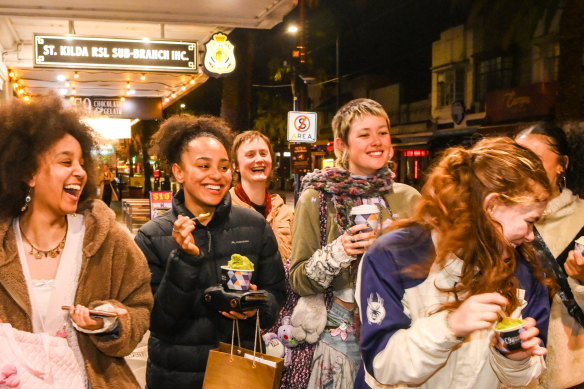Save articles for later
Add articles to your saved list and come back to them any time.
On a windy September morning, hope is down – but definitely not out – in the once-adored but now deflated community hub of Acland Street.
The face of Melbourne’s historic playground – a favourite spot to grab a slice of cake, a coffee, a bit of shopping and people-watching before a stroll along the beach – is looking gap-toothed. A whopping 23 of its once-pumping shopfronts appear to be vacant or for lease.
Nikki Laski of Monarch Cakes (photographed in 2020) fought the creation of Acland Street’s “plaza” and says traffic flow is key to restoring the strip’s vitality – and it can be done.Credit: Simon Schluter
Midweek foot traffic is thin, and longtime business owners lament the days when the cars and people buzzed through a strip made famous by the delicious recipes, warmth and hospitality of the city’s post-war wave of Jewish émigrés and refugees.
The day the music they created began to die, the stayers say, was August 8, 2016. This is when the last car drove the length of Acland Street, shortly before midnight.
From the following day, the traffic pulse was stopped at one end and stilted at the other by a pet project of Port Phillip’s then-council: construction of a tram super stop and a concrete “plaza” near Barkly Street.
“Acland Street was a perfect destination,” says Nikki Laski, whose family has run local landmark Monarch Cakes for more than two decades.
Acland Street in its heyday before traffic was halted, which traders say precipitated the decline.Credit: Michael Clayton-Jones
“It had everything: cafes, restaurants, bars, live music, fresh produce, mixed independent retail … a few minutes walk to the beach.”
“There really wasn’t anything like that anywhere. The minute they [the council, state government and Public Transport Victoria] decided to tear it up, the demise of our unique village was imminent.”
Laski was one of more than a dozen traders and residents who fought the super stop proposal vigorously, but lost.
“This council’s all about causes, but … people are still going to drive, because this is Melbourne, not Paris or Amsterdam,” says Laski, who is among those still asking for at least one side of the super stop area to be reopened to through traffic, and some parking returned.
“The things people come out of their suburbs for are not something you could put a whole family on a tram and come to from Balwyn.”
More than 50 car spots went, as did easy access for locals and visitors to rock-star parking spots outside their favourite eatery for a flying visit. In its place was a zone designed to emulate a European “corso”, but one local says it has instead proven a strong magnet for dodginess.
The Age is focusing on Acland Street as part of a series investigating crime and antisocial behaviour troubling key thoroughfares in the CBD and the inner city.
The words of one high-profile Melburnian and proprietor who closed up shop in 2023, who asked not to be named, would likely resonate for many others who have also vacated Acland Street.
Traders say reopening one side of Acland Street to traffic would give it a big boost.Credit: Jason South
“I am very emotionally invested in the area; I live in the area. We believe in the area,” he says.
“But when they blocked the street we had a year and a half of dust; sales went through the floor and they never came back.”
The customer counter at the door of his once-profitable clothing shop showed patronage dropped by 50 per cent when construction started – and it did not recover.
Turnover dropped by 60 per cent, and at the worst of times, he saw a man stabbed in the ribs by a random attacker on the shop’s CCTV. The fact the dead end created by the super stop drew undesirable activities became known, and the street got a “mums don’t like it” feel, he said.
Nick Andriotakis of Europa Cakes says restoring Acland Street’s image as a family-friendly area will help its lifeblood return.Credit: Jason South
He is one of several traders and locals who said once the Gatwick rooming house on neighbouring Fitzroy Street was closed in 2017 and transformed into upmarket apartments, trouble migrated to other parts of the area, including Acland Street.
Victoria Police report that, contrary to the image of the street as more dangerous, statistics show overall crime on Acland Street remains 23.5 per cent below pre-pandemic levels.
“This equates to 103 less criminal offences on Acland Street. This reduction is driven by offences such as burglaries, shop theft and disorderly conduct all decreasing by half,” a spokesperson said in a statement.
Statistics obtained by The Age for the five years to March show recorded offences for crimes against the person, drugs, property damage and public order are stable. They peaked at 459 in 2020 but have since hovered between 351 and 383 for the last three years.
A group of cyclists enjoy coffee on Acland Street on Thursday.Credit: Jason South
Combatting the impression that the street is not as safe without the foot traffic of the past will be essential to restoring faith in it as a family area, which traders – including Nick Andriotakis of Europa Cake Shop – say is key to restoring its vitality. He is optimistic it can be turned around.
Proof Acland Street can draw the crowds back – and that they are safe – came on Father’s Day, at the 10th anniversary of the street’s annual car show. More than 400 cars and “40,000 to 50,000 people” crammed the street and Shakespeare Grove, enjoying the sunny vibe.
“We had our biggest day of takings ever, and so did every other trader,” says Andriotakis. “It was full of families, you could hardly walk through the street.”
A strong effort by police and council officers to reduce the presence of people sleeping and using drugs on Acland Street is working, and Andriotakis insists that “St Kilda is no more dangerous than anywhere else in Melbourne”.
Head of the Acland Street Village Business Association, Janet Rosenberg, says a plan to fill the shops and restart retail offers hope.Credit: Jason South
Janet Rosenberg, head of the Acland Street Village Business Association and proprietor of the eclectic homewares store Chakra for 32 years, also believes there is plenty of life to be re-generated in St Kilda’s “Grand Old Lady” – and that the warm spot Melburnians have in their hearts for Acland Street can be re-stoked.
She has high hopes for a program to fill empty shops with pop-ups to revitalise the sense of Acland Street as an attractive shopping area. This initiative has given a big boost to Fitzroy Street, but would require landlords to agree to reduced rents to help restart the retail scene.
Rosenberg is one of several traders who mentioned the disconnect between the cost of rent and trading conditions. “The landlords are not dropping the rents enough,” she said.
“They’ve always been extremely high – there was a slight movement down just before COVID, but not much. It was still so excessive, it was bad. And then since COVID we have lost shops.
The Acland Street super stop and plaza, shortly after it was opened in 2016.Credit: Joe Armao
“This [disproportionate rents] is one of the major reasons [for the decline in occupancy] and landlords don’t seem to have accepted that. ”
Some traders say it is even difficult to pin down who the landlords are to communicate with them. Others say “old money” holds many buildings, and owners are less concerned about having shops filled than with getting the rent they want.
Rosenberg believes kick-starting shops with peppercorn rents for pop-ups would remove the turn-off factor of multiple “for lease” signs in a row on both sides of the street, “which looks really bad”.
Rosenberg and the council “are also looking at revitalising the plaza with some kind of outdoor trading going on in the spring, some kind of entertainment on a Friday and Saturday night”.
Traders were encouraged by a walk-through of the street conducted by the council, in which proprietors, council officers and members of the executive, and some landlords jointly assessed what needs updating and fixing and what could be added to rebuild the welcoming, village atmosphere.
Rosenberg said trying to reduce Acland Street’s image as a crime hotspot is still a challenge.
“I’m very aware the crime rate has absolutely decreased, it’s only the perception of safety that’s a problem,” she said.
“And police are also working with council and us to resolve that. I think in the COVID era when there were less people around, [the street] had quite prominent antisocial behaviour all congregating in the plaza, and that added to the problem.”
There is strong sentiment in the area that the day the tram stop came, it killed the street.
Laski has photographs of drug users doing methamphetamine in the street in the past, at the “non Paris end” – the plaza.
One current, long-term trader who does not wish to be named, said no matter the efforts of businesspeople, the street’s destiny is “entirely dependent on the whim of Public Transport Victoria, City of Port Phillip council and landlords who won’t reduce rents”.
She said traffic flow must be restored down one side – a point made by many traders, who believe it would “flush though” and help move remove a haven for nefarious activities.
“If they won’t remove the double-sided super stop … they have to make it a food plaza, like Oakleigh, with council providing full seating infrastructure and supported rents to entice food vendors.”
Another trader who has left the street said he believes the current council does understand “the damage done by their predecessors” by creating a “a windswept dead end”, and are trying to remedy it. But without unblocking it, this will be extremely difficult.
City of Port Phillip Mayor Heather Cunsolo told The Age that restarting car traffic and reintroducing parking on the strip was not being discussed in council.
Globe streetwear and skate store left Acland Street recently, explaining in a poster to residents that the blocking of traffic destroyed its revenue.
“The tram stop is inclusive, pram-friendly and the accessibility issues have been resolved [by it],” she said. “It is larger, can have more trams there, there are benefits.”
She concedes “there is strong sentiment in the area that the day the tram stop came, it killed the street.”
Cunsolo says efforts to improve signage for free daytime parking, removing graffiti, repairing mosaics, cleaning and making the street greener will help improve it, as would painting murals on empty shopfronts.
Social media was partly to blame for the area’s reputation for safety issues, she said, when in fact a bigger police presence was reducing risk. The number of people sleeping on the street was lower than some local social media pages suggested.
A street survey of Fitzroy Street, Acland Street and Carlisle Street in August suggested there was an average of two people sleeping rough across a two-week period, with five counted on the night of August 26.
“The numbers aren’t huge, they’re not 25 a night. It’s two on average,” Cunsolo said.
Young patrons enjoying Acland Street’s night-time vibe on Thursday.Credit: Jason South
Local residents are highly engaged over the future of the Acland Street precinct. When the Residents in St Kilda Facebook page was asked what could be done to revitalise it, the community responded with dozens of suggestions, including short-term rents for creatives, bringing back traffic and making all parking free.
Many wanted more done to support the mental health and practical needs of vulnerable people and those with addiction issues.
Pride in the area beloved by generations of Melburnians was also on display, with one resident singling out the car show as an example of what Acland Street can still be.
“Father’s Day was brilliant,” she said. “The buzz was electric and made me proud to be a resident.
“So many smart and talented people around it [rebuilding life in Acland Street] should be easy, but alas road blocks!”
The Morning Edition newsletter is our guide to the day’s most important and interesting stories, analysis and insights. Sign up here.
Most Viewed in National
From our partners
Source: Read Full Article
